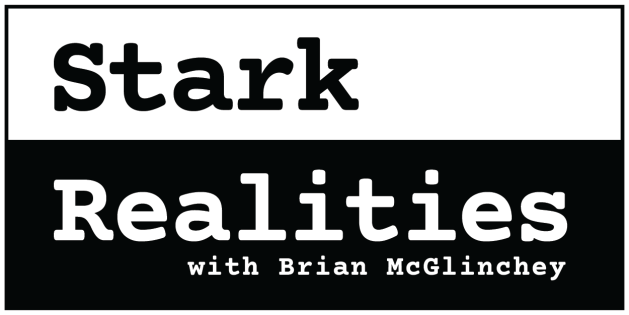This is Your Brain on Terrorism
July 23, 2013 27 Comments
The new home of Brian McGlinchey’s independent journalism is Stark Realities with Brian McGlinchey: Invigoratingly unorthodox perspectives for intellectually honest readers
Read this article on my new, reader-friendly, ad-free platform: This is Your Brain on Terrorism
Edward Snowden’s revelations about the federal government’s mass collection of phone records, emails, web browsing history and social media interactions have prompted a collective contemplation of a critical question: Should we surrender Constitutionally-enshrined liberties for the government’s promise of security against terror?
Unfortunately, our ability to reach a rational decision on this question is hampered by our humanity: While the homo sapiens brain has come a long way, it’s still wired to assess potential threats with emotion rather than reason. As a result, we’re susceptible to extreme exaggeration of the threat of terrorism and may be making a catastrophically bad bargain with our essential freedoms.
Our Lizard Brains: Wired for Snakes
Our tendency to miscalculate on terrorism is in our DNA. In a New York Times piece aptly titled “Scaring Us Senseless,” Nassim Taleb writes:
Terrorism exploits three glitches in human nature, all related to the management and perception of unusual events. The first and key among these has been observed over the last two decades by neurobiologists and behavioral scientists, who have debunked a great fallacy that has marred Western thinking since Aristotle and most acutely since the Enlightenment.
That is to say that as much as we think of ourselves as rational animals, risk avoidance is not governed by reason, cognition or intellect. Rather, it comes chiefly from our emotional system.
When assessing the terror threat, our ability to reason is further undermined by “availability bias,” the tendency to overestimate the likelihood of events that are more available in our memory banks. Since availability is amplified by the emotional impact of an event and how often we hear about it, our views on terrorism are especially prone to this effect.
Long ago, when human self-preservation was focused on perils like snakes and rival tribes, emotion- and memory-fueled threat assessment surely served us well. Today, in an era of 24-hour cable news networks and social media, the process is completely short-circuited: By the very definition of “news,” we hear very little about the dominant threats to our lives, and the most about the rarest, including terror.
Just how small is the terror threat? Consider your annual odds of perishing by terror compared to two alternatives:
- Dying in a car accident: 1 in 19,000
- Dying in a bathtub: 1 in 800,000
- Dying in a terror attack: 1 in 3.5 million
With bathtubs posing a substantially greater danger than terrorists, why are politicians silent on this menace? Why don’t they accuse rivals of being “weak on bathtubs”? Where are the recurring TV news segments? Why is there no Bureau of Bathtub Security with a $4 billion headquarters and an accompanying array of intrusive, government-mandated safety measures?
That’s absurd, some may say—bathtub deaths are accidental, and terrorist attacks are intentional!
That objection is itself a case study in reasoning warped by emotion. After all, if our government’s goal is to preserve American lives, it makes no difference whether one hazard is accidental in nature and another results from a deliberate act. Both result in grieving families. The difference in our society’s reaction to the two is found deep in our lizard brains, which assign disproportionate importance to exotic threats. If we are to pursue rational policies, however, our efforts to reduce deaths from shocking acts should carry the same sense of proportionality we apply to more mundane perils.
Availability Bias Reinforced
To do that, we must first overcome our emotional biases about terror. That’s a challenge made steeper by the role our media and government play in reinforcing them.
When it comes to other phobias like air travel and sharks, the media and government contribute to our biases, but usually make some effort to help us overcome them too. For example, after a spectacular air crash, they remind us we’re far safer in the skies than on the roads. Following their lead, individuals remind each other of that increasingly well-known fact too.
Where terrorism is concerned, the media and government almost exclusively reinforce our emotionally-charged and deeply flawed conclusions. Each has powerful incentives to do so.
Ghastly as terror attacks may be, news executives will tell you they’re great for ratings. After terror attacks like the one in Boston, networks cast all other stories aside and spend weeks positively saturating the public in images, interviews and commentary that reinforce availability bias—and provide terrorists the very publicity they sought in the first place. And, having long ago morphed from detached observers and critics of government to de facto communication outlets for it, major news organizations spend precious little time scrutinizing government claims about terror.
That’s problematic, because the government has its own incentives to exaggerate the threat. In the wake of 9/11, the United States began building a massive anti-terror bureaucracy, and the first mission of bureaucrats is to not only defend their power and budget but to expand them. To that end, they benefit more from fanning the public’s terror worries than moderating them.

Department of Homeland Security’s $4 Billion Headquarters: Still under construction, the largest project in GSA History
Terrorcrats are aided in that effort by the same potent mix of politicians, lobbyists and federal dollars that has pushed U.S. military spending far beyond its rational limits. If Eisenhower were here today, he’d surely be disturbed to find that the military-industrial complex he warned us about is now paired with a formidable terrorism-industrial complex touching more than 1,200 government organizations and 1,900 private companies and consuming billions in taxpayer money. (There’s no telling how many billions: Much of the anti-terror budget is classified, shielded from scrutiny under the absurd pretense that mere knowledge of the price tag would aid the enemy.)
Saving Lives: Weighing Costs and Benefits
We return, then, to the question at hand. Are Americans making a reasonable trade-off between:
- Government policies that are supposed to decrease our risk of dying in a terrorist attack, and
- The cost to society for the additional margin of safety actually gained?
With the shocking images and deep sadness of 9/11 understandably seared into their psyches, many Americans seem to feel that no cost is too high to ward off future attacks. However, few would reach the same conclusion about other risks.
Consider this: Some 30,000 American men, women and children die in vehicle accidents each year. Would you support a government-mandated safety feature that would spare 3,000 of those lives and add $50 to the cost of every single car? Probably.
What if it cost $500, and even current car owners were ordered to add it? How about $5,000? $15,000? $25,000?
At some point, your answer likely became “no.” It’s not because you place little value on those 3,000 American lives—a 9/11 casualty count every single year—but because you realize life is inherently risky and we have to weigh the costs, benefits and unintended consequences of our various life-preserving policies.
Which brings us back to terror. Here, the cost is measured not only in untold billions of dollars but in something even more precious: our liberties. Endangering generations to come, all three branches of the federal government have colluded to give current and future presidents and their appointees the power to engage in mass domestic surveillance, indefinite detention and execution without trial—offering us a promise of enhanced security in return.
But how much extra security are we actually getting for that price? It turns out most of the plots the FBI claims to have foiled were concocted and often even equipped by the FBI itself, coaxing a variety of social misfits into attempting attacks they didn’t have the capability to carry out on their own. Meanwhile, as the Boston Marathon bombing demonstrated, government agents aren’t nearly as skilled in thwarting attacks that weren’t their idea in the first place.
And remember, this massive and expensive effort is directed at a mortality risk that’s already among the slimmest Americans face: Despite Islamic terrorists’ dedication to destruction, our “porous” southern border and the countless low-tech means of killing people, they’ve only claimed an average of 1.6 lives per year within the United States since 9/11.
To counter that fact, defenders of domestic surveillance and other counter-terror programs will point to the same threat their confederates used to justify the invasion of Iraq: What if the terrorists go nuclear? For a variety of reasons, their prospects of making the leap from box-cutters and pressure cookers to a nuclear bomb are almost unfathomably slim.
Caveat Emptor
None of that is to say we shouldn’t make any effort to thwart terror. The question is whether today’s extraordinarily expensive and un-Constitutional measures represent a rational, cost-effective and proportionate response to the danger terrorism truly presents—not in the emotion-laden recesses of our lizard brains, but in the real world.
In the domestic war on terror, the federal government is essentially making this offer to the American people: “Give up your Bill of Rights and plunge the country far deeper into debt, and I’ll improve your risk of dying in a terror attack from one in 3,500,000 to—who knows—one in 3,501,000.”
Considering what we’re being offered, giving away the protections we fought a revolution to achieve is a bargain so outrageously lopsided that future historians will certainly marvel at what is unfolding today.
Given what Americans are up against—their own flawed reasoning and an imposing set of forces with powerful incentives to exaggerate the risk of terror—there’s little reason to hope a majority can be persuaded they’re paying an obscene price for the slimmest margin of additional safety against an already-modest risk.
But we have to try.
The new home of Brian McGlinchey’s independent journalism is Stark Realities with Brian McGlinchey, a Substack newsletter that undermines official narratives, demolishes conventional wisdom and exposes fundamental myths across the political spectrum.
Read this article on my new, reader-friendly, ad-free platform: This is Your Brain on Terrorism
→→ Visit Stark Realities with Brian McGlinchey


